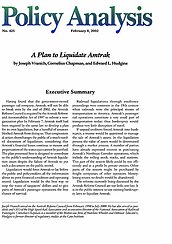Liquidation would force Amtrak to lay before the public and policymakers all the information about its poor financial condition and operating record. Liquidation would be the best way to stop the waste of taxpayers’ dollars and to give parts of Amtrak’s passenger operations the best chance of survival.
Railroad liquidations through insolvency proceedings were common in the 19th century when railroads were the principal means of transportation in America. Amtrak’s passenger rail operations constitute a very small part of transportation today; thus bankruptcy would produce very little disruption of travel.
If unpaid creditors forced Amtrak into bankruptcy, a trustee would be appointed to manage the sale of Amtrak’s assets. In the liquidation process the value of assets would be determined through a market process. A number of parties have already expressed interest in purchasing Amtrak’s Northeast Corridor operations, which include the rolling stock, tracks, and stations. This part of the system likely could be run efficiently and at a profit by private owners. Other parts of the system might be purchased by freight companies of other operators. Money-losing routes no doubt would be abandoned.
The reforms currently being discussed by the Amtrak Reform Council are too little, too late. It is in the public interest to use existing bankruptcy laws to liquidate Amtrak.

